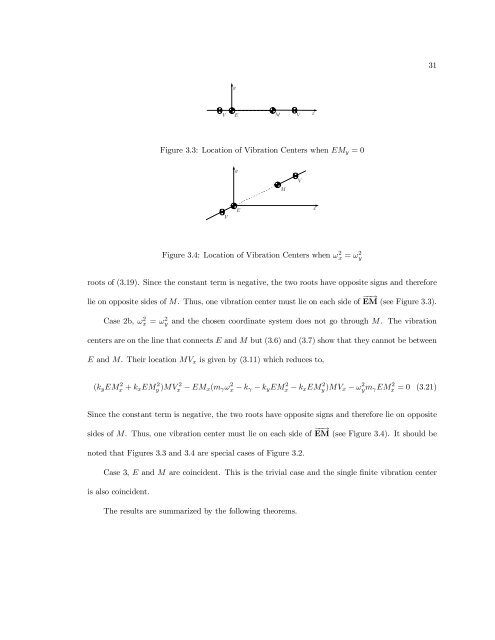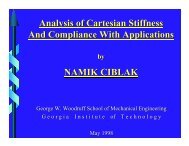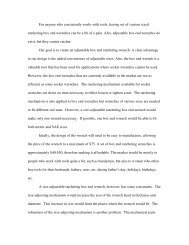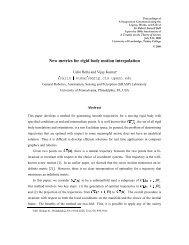- Page 3 and 4: iiiDEDICATIONÀ mon …ls Matthieu
- Page 6 and 7: vi5 FORCED VIBRATIONS : : : : : : :
- Page 9 and 10: ixSUMMARYA novel analysis is propos
- Page 11 and 12: CHAPTER IINTRODUCTIONThe purpose of
- Page 13 and 14: 3properties have canonical forms: f
- Page 15 and 16: 5mode shape problem where eigendata
- Page 17 and 18: 7where ~v O and ~ Á are respective
- Page 19 and 20: 9yOA, I x , I y , Y, LMxm, m γFigu
- Page 21: 1123·~T M =¸ T 1 T 2 T 3=640 0 00
- Page 24 and 25: 14twist it induces the form T E = P
- Page 26 and 27: where ~r S f and ~rC °are respecti
- Page 28 and 29: 18m fi are all equal and represent
- Page 30 and 31: 20Consider any wrench contained in
- Page 32 and 33: 22on the subject is extensive [15],
- Page 34 and 35: 24VEMyzxFigure 3.1: Elastically Sus
- Page 36 and 37: 26! 2 =k ° + k x EVy 2 + k y EVx2m
- Page 38 and 39: 28·where ^T M =~ ±T0¸Tis a trans
- Page 42 and 43: 32Theorem 10 When the center of mas
- Page 44 and 45: 34where MV x1 , MV x2 , MV x3 are t
- Page 46 and 47: 36At the center of mass,2M M =64m 0
- Page 48 and 49: 38yV 2OMEV 1TranslationalDirectionx
- Page 50 and 51: CHAPTER IVTRANSLATION AND COUPLE MO
- Page 52 and 53: 42δw rFigure 4.2: Pure Translation
- Page 54 and 55: 444.2.1 Translation ModeThe two equ
- Page 56 and 57: 46sti¤ness and mass matrices have
- Page 58 and 59: 484.3.1 Translation modeIt is known
- Page 60 and 61: 50matrix and,23k tr =640 0 0a b cd
- Page 62 and 63: 52rotations which intersect at M. T
- Page 64 and 65: 54direct consequence of assuming eq
- Page 66 and 67: 56be rewritten as,~ fTi~ ±1 = ~ ±
- Page 68 and 69: 58produced by a couple mode. The pr
- Page 70 and 71: 60should then be a pure translation
- Page 72 and 73: 62be represented as,K M = X T EMK E
- Page 74 and 75: 64means that one principal sti¤nes
- Page 76 and 77: 66Substituting (4.61) and (4.62) in
- Page 78 and 79: 68δ 2δ 3τ 1E; MFigure 4.7: Coupl
- Page 80 and 81: 70Equation (4.74) represents the ei
- Page 82 and 83: 72² Design K 2 such that ^w is one
- Page 84 and 85: 74Equation (4.83) shows that k fcan
- Page 86 and 87: 76make the common eigentwists paral
- Page 88 and 89: 78Note that ^w transforms according
- Page 90 and 91:
80The proposed design places 13 con
- Page 92 and 93:
82construction is a problem of sti
- Page 94 and 95:
84where·¸2~ f2 ~ f3 p 6=66430 ¡2
- Page 96 and 97:
86fStiffnessAxisM 2Body 2Body 1τ M
- Page 98 and 99:
88the centers of mass and elasticit
- Page 100 and 101:
90where the vector from E 2 to M 2
- Page 102 and 103:
92where the arbitrary linear princi
- Page 104 and 105:
94² The linear mass of the absorbe
- Page 106 and 107:
96Pfk x kγ k yFigure 4.13: Possibl
- Page 108 and 109:
98specialized to systems exhibiting
- Page 110 and 111:
100where ! 2 j is the natural frequ
- Page 112 and 113:
102V 1V 2ffτ MMV 3Figure 5.3: Mode
- Page 114 and 115:
104γ iαMMV iMFV i FfFigure 5.4: L
- Page 116 and 117:
106Equation (5.20) reveals that the
- Page 118 and 119:
108Substituting (5.23) into (5.22)
- Page 120 and 121:
110V 1EYMYMV 2V 3Figure 5.6: Mode 1
- Page 122 and 123:
112δEMV 2V 3V 1Figure 5.8: Mode 1
- Page 124 and 125:
114a planar rotating unbalance for
- Page 126 and 127:
116undamped, underdamped, criticall
- Page 128 and 129:
118The location of point V is given
- Page 130 and 131:
Note that ¡! AV can also be found
- Page 132 and 133:
122For planar motion, the eigenvect
- Page 134 and 135:
124Aδ δxδByBxyB AδA By− δx
- Page 136 and 137:
126position. This observation means
- Page 138 and 139:
Equation (6.53) reveals that the vi
- Page 140 and 141:
130¯c ¯± B A¯Equation (6.64) re
- Page 142 and 143:
13221.51Mode 1Mode 2Mode 3Imaginary
- Page 144 and 145:
Y134-0.4-0.5-0.6-0.7Point APoint BM
- Page 146 and 147:
13676δ ΑB543Mode 1Mode 2Mode 3210
- Page 148 and 149:
138where A and B are any points on
- Page 150 and 151:
140where^W A = K^T A^W B = K^T BEqu
- Page 152 and 153:
142where c = p ¤ =p. Equation (6.9
- Page 154 and 155:
1442z 0-2420x-2-4420y-2-4Figure 6.1
- Page 156 and 157:
146Equation (6.106) shows that the
- Page 158 and 159:
1486.2.4 Overdamped ModesThe eigenv
- Page 160 and 161:
150where ¸j and X j are respective
- Page 162 and 163:
152Equations (6.131) reveal that ^w
- Page 164 and 165:
154Hence the orthogonality conditio
- Page 166 and 167:
156If ~ f R and ~ f I are linearly
- Page 168 and 169:
CHAPTER VIIOTHER RESULTSThis chapte
- Page 170 and 171:
160(S) to coalesce, for the centers
- Page 172 and 173:
162As before, all three ~r i = ~0 w
- Page 174 and 175:
164The previous Theorem proved that
- Page 176 and 177:
166Proof.From Theorem 49, the eigen
- Page 178 and 179:
168the eigenwrenches with respect t
- Page 180 and 181:
170eigentwists of the damping matri
- Page 182 and 183:
172Equation (7.53) shows that the e
- Page 184 and 185:
174and inertia matrices to intersec
- Page 186 and 187:
176In Chapter 4, the occurrence of
- Page 188 and 189:
178APPENDIXA. Proof of Critically D
- Page 190 and 191:
180where S is a non-singular matrix
- Page 192 and 193:
182Equation (A.3) can be written as
- Page 194 and 195:
184REFERENCES[1] Anton, H., 1984, E
- Page 196 and 197:
186[35] Patterson, T. and Lipkin, H













